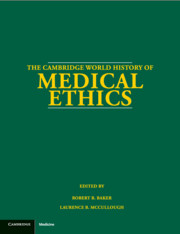Book contents
- Frontmatter
- PART I AN INTRODUCTION TO THE HISTORY OF MEDICAL ETHICS
- PART II A CHRONOLOGY OF MEDICAL ETHICS
- PART III DISCOURSES OF MEDICAL ETHICS THROUGH THE LIFE CYCLE
- PART IV THE DISCOURSES OF RELIGION ON MEDICAL ETHICS
- PART V THE DISCOURSES OF PHILOSOPHY ON MEDICAL ETHICS
- PART VI THE DISCOURSES OF PRACTITIONERS ON MEDICAL ETHICS
- PART VII THE DISCOURSES OF BIOETHICS
- PART VIII DISCOURSES ON MEDICAL ETHICS AND SOCIETY
- Ethical and Legal Regulation of Medical Practice and Research
- B Medical Ethics, Imperialism, and the Nation-State
- C Medical Ethics and Health Policy
- 59 Making Distinctions “Natural”: The Science of Social Categorization in the United States in the Twentieth Century
- 60 History of Public Health Ethics in the United States
- 61 Ethics and Health Policy in the United Kingdom and the United States: Legislation and Regulation
- 62 Ethical Issues in Organ Transplantation in the United States
- 63 Defining and Redefining Life and Death
- Appendix: Biographies: Who Was Who in the History of Medical Ethics
- Bibliography
- Index
62 - Ethical Issues in Organ Transplantation in the United States
from C - Medical Ethics and Health Policy
Published online by Cambridge University Press: 28 May 2012
- Frontmatter
- PART I AN INTRODUCTION TO THE HISTORY OF MEDICAL ETHICS
- PART II A CHRONOLOGY OF MEDICAL ETHICS
- PART III DISCOURSES OF MEDICAL ETHICS THROUGH THE LIFE CYCLE
- PART IV THE DISCOURSES OF RELIGION ON MEDICAL ETHICS
- PART V THE DISCOURSES OF PHILOSOPHY ON MEDICAL ETHICS
- PART VI THE DISCOURSES OF PRACTITIONERS ON MEDICAL ETHICS
- PART VII THE DISCOURSES OF BIOETHICS
- PART VIII DISCOURSES ON MEDICAL ETHICS AND SOCIETY
- Ethical and Legal Regulation of Medical Practice and Research
- B Medical Ethics, Imperialism, and the Nation-State
- C Medical Ethics and Health Policy
- 59 Making Distinctions “Natural”: The Science of Social Categorization in the United States in the Twentieth Century
- 60 History of Public Health Ethics in the United States
- 61 Ethics and Health Policy in the United Kingdom and the United States: Legislation and Regulation
- 62 Ethical Issues in Organ Transplantation in the United States
- 63 Defining and Redefining Life and Death
- Appendix: Biographies: Who Was Who in the History of Medical Ethics
- Bibliography
- Index
Summary
INTRODUCTION
The modern era of human solid organ transplantation began in the 1950s, when the first successful outcomes began to be achieved with live donor kidney transplants. During these early years of clinical transplants, however, successful results were rare and usually ephemeral, given the many unknown and uncontrolled factors involved in moving from the animal laboratory to humans and the drastic illnesses of the patients. Pioneering transplant surgeon Francis D. Moore has called the decade from 1952–1962 the “black years” between the introduction of whole body radiation and the discovery of immunosuppressive chemotherapy to forestall the inexorable rejection of an organ from anyone but an identical twin (Moore 1968, 384). By 1963, 194 kidney transplants had been reported in the literature; of the 103 non-twin transplants in this total, fewer than 10 percent survived for 3 months (Goodwin and Martin 1963).
Kidneys also began to be obtained from the “newly dead” – from cadaveric donors. Beyond the limited supply of live donors, there were other reasons, both explicit and latent, why transplant surgeons showed a growing preference for cadaveric organs. Foremost among these reasons has been the deep concern, bordering on dread, about the fact that live organ transplantation engages them in an act that deliberately inflicts surgical damage on a healthy person, albeit for the good of someone else.
- Type
- Chapter
- Information
- The Cambridge World History of Medical Ethics , pp. 678 - 683Publisher: Cambridge University PressPrint publication year: 2008



